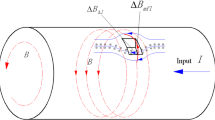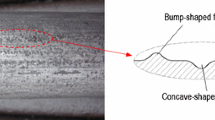Abstract
Nondestructive testing for ferromagnetic material equipment based on low-frequency electromagnetic technique (LFET) and signal difference is proposed. Magnetic field distributions of the defect area in or on the 20# steel surfaces are analyzed using the finite element method (FEM) based on COMSOL Multiphysics. After the signal difference converting, for a surface defect in the 1.2 to 9.6 mm depth, amplitude voltage ranges of 1.8 to 4.2 V and 2.5 to 3.5 V are obtained for the defects in 20# steel plate and pipe, respectively. In addition, compared with the traditional MFL, the 4.8-mm buried internal depth and the 9.6-mm depth surface defect are detected in the 12-mm-thick 20# steel plate or pipe, which is about 1.6 times higher than that of the current similar sensors.











Similar content being viewed by others
Data availability
The data are available from the corresponding author on reasonable request.
References
Lou W, Shen C, Zhu Z, Liu Z, Shentu F, Xu W, Lang T, Zhang Y, Jing Z, Peng W (2018) Internal defect detection in ferromagnetic material equipment based on low-frequency electromagnetic technique in 20# steel plate. IEEE Sens J 18(16):6540–6546
Li M, Feng X (2022) Multisensor data fusion-based structural health monitoring for buried metallic pipelines under complicated stress states. J Civ Struct Heal Monit 12:1509–1521
Li M, Feng X, Han Y (2022) Brillouin fiber optic sensors and mobile augmented reality-based digital twins for quantitative safety assessment of underground pipelines. Autom Constr 144:104617
Yan Y, Zou L, Zhou X (2016) Nondestructive inspect ion of steel bridge based on infrared thermal imaging. J Appl Sci 34(1):106–114
Wang Y, Gao B, Woo WL et al (2018) Thermal pattern contrast diagnostic of micro cracks with induction thermography for aircraft breaking components. IEEE Trans Industr Inf 14(12):5563–5574
Chai M, Zhang Z, Duan Q et al (2018) Assessment of fatigue crack growth in 316LN stainless steel based on acoustic emission entropy. Int J Fatigue 109(4):145–156
Jiao J, Chang Y, Wu C (2017) Detection of heterogeneous deposits on the surface of metal structures using nonlinear acoustic resonance technology. Surf Topogr Metrol Prop 5(4):1–11
Dutta SM, Ghorbel FH, Stanley RK (2009) Dipole modeling of magnetic flux leakage. IEEE Trans Magn 45(4):1959–1965
Ma C, Liu Y, Shen C (2022) Phase-extraction-based MFL testing for subsurface defect in ferromagnetic steel plate. Sensors 22:3322
Sun Y, Kang Y, Qiu C (2009) A permanent magnetic perturbation testing sensor. Sens Actuator A Phys 155(2):226–232
Gao B, Lok WW, Tian GY (2016) Electromagnetic thermography nondestructive evaluation: physics-based modeling and pattern mining. Sci Rep 6:25480
Wincheski B, Yu F, Simpon J et al (2010) Development of SDT sensor based eddy current probe for detection of deep fatigue cracks in multi-layer structure. NDT and E Int 43(8):718–725
Augustyniak M, Usarek Z (2016) Finite element method applied in electromagnetic NDTE: a review. J Nondestr Eval 35(3):1–15
Han B, Xu Q, Yuan Q (2015) Multiobjective optimization of a combined radial-Axial magnetic bearing for magnetically suspended compressor. IEEE Trans Industr Electron 63(4):2284–2293
Guo L, Zhang H, Galea M (2016) Multiobjective optimization of a magnetically levitated planar motor with multilayer windings. IEEE Trans Industr Electron 63(6):3522–3532
Wu B, Wang YJ, Liu XC et al (2015) A novel TMR-based MFL sensor for steel wire rope inspection using the orthogonal test method. Smart Mater Struct 24(7):1–12
Parra-Raad JA, Roa-Prada S (2016) Multi-objective optimization of a magnetic circuit for magnetic flux leakage-type non-destructive testing. J Nondestr Eval 35(1):1–12
Cheng W (2016) Magnetic flux leakage testing of reverse side wall-thinning by using very low strength magnetization. J Nondestr Eval 35(2):1–9
Tao X, Wang ZH, Zhang ZT, Zhang DP, Xu D, Gongx Y (2018) Wire defect recognition of spring-wire socket using multitask convolutional neural networks. IEEE Trans Compon Packag Manufact Technol 8(4):689–698
Wei B, Hao K, Tang XS, Ding Y (2019) A new method using the convolutional neural network with com-pressive sensing for fabric defect classification based on small sample sizes. Tertile Res J 89(17):3539–3555
Wu S, Wu Y, Cao D, Zheng C (2019) A fast button surface defect detection method based on Siamese network with imbalanced samples. Multimed Tools Appl 78(24):34627–34645
Cha YJ, Choi W, Buyukzturk O (2017) Deep learning-based crack danage detection using convolutional neural net-works. Comput Aided Infrastruct Eng 32(5):361–378
Ren R, Hung T, Tan KC (2017) A generic deep-learning-based approach for automated surface inspection. IEEE Trans Cybern 48(3):929–940
Acknowledgements
National Key R & D Program of China (2021YFF0600203), National Natural Science Foundation of China (12274386), Key R & D plan of Zhejiang Province (2021C01179) and Zhejiang Provincial Natural Science Foundation of China (LY21F050006).
Author information
Authors and Affiliations
Corresponding author
Additional information
Publisher's Note
Springer Nature remains neutral with regard to jurisdictional claims in published maps and institutional affiliations.
Rights and permissions
Springer Nature or its licensor (e.g. a society or other partner) holds exclusive rights to this article under a publishing agreement with the author(s) or other rightsholder(s); author self-archiving of the accepted manuscript version of this article is solely governed by the terms of such publishing agreement and applicable law.
About this article
Cite this article
Yang, J., Liu, Z., Li, X. et al. Signal difference-based nondestructive low-frequency electromagnetic testing for ferromagnetic material pipe equipment. J Civil Struct Health Monit 14, 59–66 (2024). https://doi.org/10.1007/s13349-023-00694-5
Received:
Accepted:
Published:
Issue Date:
DOI: https://doi.org/10.1007/s13349-023-00694-5




